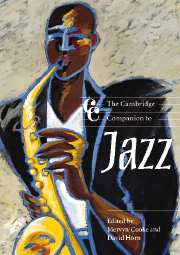12 - Fusions and crossovers
from Part Three - Jazz changes
Published online by Cambridge University Press: 28 September 2011
Summary
While it remains a fascination that one of the first recordings of African-American music was made in Sweden in 1899 – ‘Cake Walk’ (a version of ‘At A Georgia Camp Meeting’ by Kerry Mills), by the Kronoberg Society Regimental Band conducted by Erik Högberg – the first jazz recording is usually cited as ‘Darktown Strutters Ball’ by the Original Dixieland Jazz Band from January 1917. Prior to that we can only guess what the music might have sounded like as a deliquescent folk music in the rural southern states of America. But we do know that early jazz drew together several strands of vernacular music, including Negro spirituals, work and folk songs, ragtime, minstrel music, brass-band music and blues, that were freely mixed with elements from hymns, popular songs and popular classics of the day.
From the start, jazz was a pluralistic music. One of its great early practitioners, Jelly Roll Morton, argued that the music should always include a ‘Spanish tinge’ while the unambiguous habañera section in St Louis Blues, published by W. C. Handy in 1914, is revealing of jazz's practice of appropriation; an important, if often neglected, feature of a music that already comprised a diversity of elements drawn from a variety of sources both from within and without the African-American diaspora.
- Type
- Chapter
- Information
- The Cambridge Companion to Jazz , pp. 217 - 252Publisher: Cambridge University PressPrint publication year: 2003
- 1
- Cited by



